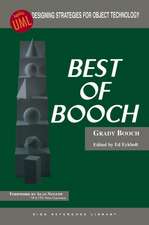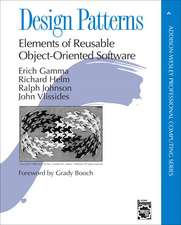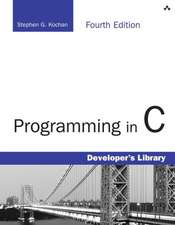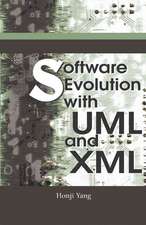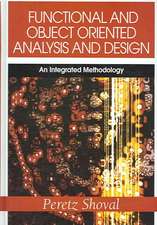Object-Oriented Analysis and Design with Applications: Addison-Wesley Object Technology Series
Autor Grady Booch, Robert A. Maksimchuk, Michael W. Engelen Limba Engleză Hardback – 31 mar 2007
The previous editions of this book have taught tens of thousands how to apply the concepts and ideas behind object technology to design successful software applications. This revision will bring the book up to date with the many changes in technology that have happened since the second edition was first published in 1994. New topics covered in the third edition include the Unified Software Development Process, UML, Patterns, Java, and Components.
Preț: 483.02 lei
Preț vechi: 603.78 lei
-20% Nou
Puncte Express: 725
Preț estimativ în valută:
92.44€ • 96.15$ • 76.31£
92.44€ • 96.15$ • 76.31£
Carte disponibilă
Livrare economică 24 martie-07 aprilie
Preluare comenzi: 021 569.72.76
Specificații
ISBN-13: 9780201895513
ISBN-10: 020189551X
Pagini: 720
Ilustrații: Illustrations
Dimensiuni: 185 x 243 x 40 mm
Greutate: 1.18 kg
Ediția:Nouă
Editura: Addison-Wesley Professional
Seria Addison-Wesley Object Technology Series
Locul publicării:Boston, United States
ISBN-10: 020189551X
Pagini: 720
Ilustrații: Illustrations
Dimensiuni: 185 x 243 x 40 mm
Greutate: 1.18 kg
Ediția:Nouă
Editura: Addison-Wesley Professional
Seria Addison-Wesley Object Technology Series
Locul publicării:Boston, United States
Public țintă
Academic/professional/technical: Research and professionalDescriere
Object-Oriented Design with Applications has long been the essential reference to object-oriented technology, which, in turn, has evolved to join the mainstream of industrial-strength software development. In this third edition--the first revision in 13 years--readers can learn to apply object-oriented methods using new paradigms such as Java, the Unified Modeling Language (UML) 2.0, and .NET.
The authors draw upon their rich and varied experience to offer improved methods for object development and numerous examples that tackle the complex problems faced by software engineers, including systems architecture, data acquisition, cryptoanalysis, control systems, and Web development. They illustrate essential concepts, explain the method, and show successful applications in a variety of fields. You'll also find pragmatic advice on a host of issues, including classification, implementation strategies, and cost-effective project management.
New to this new edition are
Sidebars
Preface
Acknowledgments
About the Authors
Section I: Concepts
Chapter 1: Complexity
Chapter 2: The Object Model
Chapter 3: Classes and Objects
Chapter 4: Classification
Section II: Method
Chapter 5: Notation
Chapter 6: Process
Chapter 7: Pragmatics
Chapter 8: System Architecture: Satellite-Based Navigation
Chapter 9: Control System: Traffic Management
Chapter 10: Artificial Intelligence: Cryptanalysis
Chapter 11: Data Acquisition: Weather Monitoring Station
Chapter 12: Web Application: Vacation Tracking System
Appendix A: Object-Oriented Programming Languages
Appendix B: Further Reading
Notes
Glossary
Classified Bibliography
Index
The authors draw upon their rich and varied experience to offer improved methods for object development and numerous examples that tackle the complex problems faced by software engineers, including systems architecture, data acquisition, cryptoanalysis, control systems, and Web development. They illustrate essential concepts, explain the method, and show successful applications in a variety of fields. You'll also find pragmatic advice on a host of issues, including classification, implementation strategies, and cost-effective project management.
New to this new edition are
- An introduction to the new UML 2.0, from the notation's most fundamental and advanced elements with an emphasis on key changes
- New domains and contexts
- A greatly enhanced focus on modeling--as eagerly requested by readers--with five chapters that each delve into one phase of the overall development lifecycle.
- Fresh approaches to reasoning about complex systems
- An examination of the conceptual foundation of the widely misunderstood fundamental elements of the object model, such as abstraction, encapsulation, modularity, and hierarchy
- How to allocate the resources of a team of developers and mange the risks associated with developing complex software systems
- An appendix on object-oriented programming languages
Sidebars
Preface
Acknowledgments
About the Authors
Section I: Concepts
Chapter 1: Complexity
Chapter 2: The Object Model
Chapter 3: Classes and Objects
Chapter 4: Classification
Section II: Method
Chapter 5: Notation
Chapter 6: Process
Chapter 7: Pragmatics
Chapter 8: System Architecture: Satellite-Based Navigation
Chapter 9: Control System: Traffic Management
Chapter 10: Artificial Intelligence: Cryptanalysis
Chapter 11: Data Acquisition: Weather Monitoring Station
Chapter 12: Web Application: Vacation Tracking System
Appendix A: Object-Oriented Programming Languages
Appendix B: Further Reading
Notes
Glossary
Classified Bibliography
Index
Cuprins
Sidebars xi
Preface xiii
Acknowledgments xix
About the Authors xxiSection I: Concepts 1Chapter 1: Complexity 3 1.1 The Structure of Complex Systems 4
1.2 The Inherent Complexity of Software 7
1.3 The Five Attributes of a Complex System 12
1.4 Organized and Disorganized Complexity 14
1.5 Bringing Order to Chaos 18
1.6 On Designing Complex Systems 24
Chapter 2: The Object Model 29 2.1 The Evolution of the Object Model 29
2.2 Foundations of the Object Model 37
2.3 Elements of the Object Model 43
2.4 Applying the Object Model 71
Chapter 3: Classes and Objects 75 3.1 The Nature of an Object 75
3.2 Relationships among Objects 88
3.3 The Nature of a Class 92
3.4 Relationships among Classes 96
3.5 The Interplay of Classes and Objects 111
3.6 On Building Quality Classes and Objects 112
Chapter 4: Classification 121 4.1 The Importance of Proper Classification 121
4.2 Identifying Classes and Objects 126
4.3 Key Abstractions and Mechanisms 138
Section II: Method 145Chapter 5: Notation 147 5.1 The Unified Modeling Language 147
5.2 Package Diagrams 155
5.3 Component Diagrams 163
5.4 Deployment Diagrams 171
5.5 Use Case Diagrams 175
5.6 Activity Diagrams 185
5.7 Class Diagrams 192
5.8 Sequence Diagrams 206
5.9 Interaction Overview Diagrams 213
5.10 Composite Structure Diagrams 215
5.11 State Machine Diagrams 218
5.12 Timing Diagrams 231
5.13 Object Diagrams 235
5.14 Communication Diagrams 238
Chapter 6: Process 247 6.1 First Principles 248
6.2 The Macro Process: The Software Development Lifecycle 256
6.3 The Micro Process: The Analysis and Design Process 272
Chapter 7: Pragmatics 303 7.1 Management and Planning 304
7.2 Staffing 308
7.3 Release Management 312
7.4 Reuse 314
7.5 Quality Assurance and Metrics 316
7.6 Documentation 320
7.7 Tools 322
7.8 Special Topics 324
7.9 The Benefits and Risks of Object-Oriented Development 326
Section III: Applications 331Chapter 8: System Architecture: Satellite-Based Navigation 333 8.1 Inception 334
8.2 Elaboration 347
8.3 Construction 370
8.4 Post-Transition 371
Chapter 9: Control System: Traffic Management 375 9.1 Inception 376
9.2 Elaboration 385
9.3 Construction 396
9.4 Post-Transition 411
Chapter 10: Artificial Intelligence: Cryptanalysis 413 10.1 Inception 414
10.2 Elaboration 421
10.3 Construction 427
10.4 Post-Transition 446
Chapter 11: Data Acquisition: Weather Monitoring Station 449 11.1 Inception 450
11.2 Elaboration 463
11.3 Construction 474
11.4 Post-Transition 487
Chapter 12: Web Application: Vacation Tracking System 489 12.1 Inception 490
12.2 Elaboration 494
12.3 Construction 506
12.4 Transition and Post-Transition 534
Appendix A: Object-Oriented Programming Languages 537 A.1 Language Evolution 537
A.2 Smalltalk 541
A.3 C++ 546
A.4 Java 551
Appendix B: Further Reading 557Notes 567
Glossary 591
Classified Bibliography 603
Index 677
Preface xiii
Acknowledgments xix
About the Authors xxiSection I: Concepts 1Chapter 1: Complexity 3 1.1 The Structure of Complex Systems 4
1.2 The Inherent Complexity of Software 7
1.3 The Five Attributes of a Complex System 12
1.4 Organized and Disorganized Complexity 14
1.5 Bringing Order to Chaos 18
1.6 On Designing Complex Systems 24
Chapter 2: The Object Model 29 2.1 The Evolution of the Object Model 29
2.2 Foundations of the Object Model 37
2.3 Elements of the Object Model 43
2.4 Applying the Object Model 71
Chapter 3: Classes and Objects 75 3.1 The Nature of an Object 75
3.2 Relationships among Objects 88
3.3 The Nature of a Class 92
3.4 Relationships among Classes 96
3.5 The Interplay of Classes and Objects 111
3.6 On Building Quality Classes and Objects 112
Chapter 4: Classification 121 4.1 The Importance of Proper Classification 121
4.2 Identifying Classes and Objects 126
4.3 Key Abstractions and Mechanisms 138
Section II: Method 145Chapter 5: Notation 147 5.1 The Unified Modeling Language 147
5.2 Package Diagrams 155
5.3 Component Diagrams 163
5.4 Deployment Diagrams 171
5.5 Use Case Diagrams 175
5.6 Activity Diagrams 185
5.7 Class Diagrams 192
5.8 Sequence Diagrams 206
5.9 Interaction Overview Diagrams 213
5.10 Composite Structure Diagrams 215
5.11 State Machine Diagrams 218
5.12 Timing Diagrams 231
5.13 Object Diagrams 235
5.14 Communication Diagrams 238
Chapter 6: Process 247 6.1 First Principles 248
6.2 The Macro Process: The Software Development Lifecycle 256
6.3 The Micro Process: The Analysis and Design Process 272
Chapter 7: Pragmatics 303 7.1 Management and Planning 304
7.2 Staffing 308
7.3 Release Management 312
7.4 Reuse 314
7.5 Quality Assurance and Metrics 316
7.6 Documentation 320
7.7 Tools 322
7.8 Special Topics 324
7.9 The Benefits and Risks of Object-Oriented Development 326
Section III: Applications 331Chapter 8: System Architecture: Satellite-Based Navigation 333 8.1 Inception 334
8.2 Elaboration 347
8.3 Construction 370
8.4 Post-Transition 371
Chapter 9: Control System: Traffic Management 375 9.1 Inception 376
9.2 Elaboration 385
9.3 Construction 396
9.4 Post-Transition 411
Chapter 10: Artificial Intelligence: Cryptanalysis 413 10.1 Inception 414
10.2 Elaboration 421
10.3 Construction 427
10.4 Post-Transition 446
Chapter 11: Data Acquisition: Weather Monitoring Station 449 11.1 Inception 450
11.2 Elaboration 463
11.3 Construction 474
11.4 Post-Transition 487
Chapter 12: Web Application: Vacation Tracking System 489 12.1 Inception 490
12.2 Elaboration 494
12.3 Construction 506
12.4 Transition and Post-Transition 534
Appendix A: Object-Oriented Programming Languages 537 A.1 Language Evolution 537
A.2 Smalltalk 541
A.3 C++ 546
A.4 Java 551
Appendix B: Further Reading 557Notes 567
Glossary 591
Classified Bibliography 603
Index 677
Notă biografică
Grady Booch is an IBM fellow and author of six best-selling books on object-oriented programming. He is world-reknowned as an originator of OO and founder of UML.
Robert A. Maksimchuk, as Research Director in the Unisys CTO Office, focuses on emerging modeling technologies to advance the strategic direction of the Unisys 3D-Visual Enterprise modeling framework. Bob brings an abundance of systems engineering, modeling, and object-oriented analysis and design expertise, in numerous industries, to this mission. He is the coauthor of the books UML for Mere Mortals and UML for Database Design, has written various articles, has traveled worldwide as a featured speaker in numerous technology forums, and led workshops and seminars on UML and object-oriented development.
Michael W. Engle is a principal member of the engineering staff with the Lockheed Martin Corporation. He has extensive technical and management experience across the complete system development lifecycle, from project initiation through deployment and support in a variety of application domains. As a systems architect, Mike employs object-oriented analysis nad design techniques in complex systems development.
Dr. Bobbi Young is a Director of Research for the Unisys Chief Technology Office. She has many years of experience in the IT industry working with commercial companies and Department of Defense contractors. Dr. Young has been a consultant mentoring in program management, enterprise architecture, systems engineering, and object-oriented analysis and design. Throughout her career, she has focused on system lifecycle processes and methodologies, and enterprise architecture.
Jim Conallen is a software engineer in IBM Rational's Model Driven Development Strategy team, where he is actively involved in applying the Object Management Group's (OMG) Model Driven Architecture (MDA) initiative to IBM Rational's model tooling.
Kelli A. Houston is a Consulting IT Specialist at IBM Rational. She is the method architect for IBM's internal method authoring method and is part of the team responsible for integrating IBM's methods.
Robert A. Maksimchuk, as Research Director in the Unisys CTO Office, focuses on emerging modeling technologies to advance the strategic direction of the Unisys 3D-Visual Enterprise modeling framework. Bob brings an abundance of systems engineering, modeling, and object-oriented analysis and design expertise, in numerous industries, to this mission. He is the coauthor of the books UML for Mere Mortals and UML for Database Design, has written various articles, has traveled worldwide as a featured speaker in numerous technology forums, and led workshops and seminars on UML and object-oriented development.
Michael W. Engle is a principal member of the engineering staff with the Lockheed Martin Corporation. He has extensive technical and management experience across the complete system development lifecycle, from project initiation through deployment and support in a variety of application domains. As a systems architect, Mike employs object-oriented analysis nad design techniques in complex systems development.
Dr. Bobbi Young is a Director of Research for the Unisys Chief Technology Office. She has many years of experience in the IT industry working with commercial companies and Department of Defense contractors. Dr. Young has been a consultant mentoring in program management, enterprise architecture, systems engineering, and object-oriented analysis and design. Throughout her career, she has focused on system lifecycle processes and methodologies, and enterprise architecture.
Jim Conallen is a software engineer in IBM Rational's Model Driven Development Strategy team, where he is actively involved in applying the Object Management Group's (OMG) Model Driven Architecture (MDA) initiative to IBM Rational's model tooling.
Kelli A. Houston is a Consulting IT Specialist at IBM Rational. She is the method architect for IBM's internal method authoring method and is part of the team responsible for integrating IBM's methods.
Textul de pe ultima copertă
Object-Oriented Design with Applications has long been the essential reference to object-oriented technology, which, in turn, has evolved to join the mainstream of industrial-strength software development. In this third edition--the first revision in 13 years--readers can learn to apply object-oriented methods using new paradigms such as Java, the Unified Modeling Language (UML) 2.0, and .NET.The authors draw upon their rich and varied experience to offer improved methods for object development and numerous examples that tackle the complex problems faced by software engineers, including systems architecture, data acquisition, cryptoanalysis, control systems, and Web development. They illustrate essential concepts, explain the method, and show successful applications in a variety of fields. You'll also find pragmatic advice on a host of issues, including classification, implementation strategies, and cost-effective project management.New to this new edition areAn introduction to the new UML 2.0, from the notation's most fundamental and advanced elements with an emphasis on key changesNew domains and contextsA greatly enhanced focus on modeling--as eagerly requested by readers--with five chapters that each delve into one phase of the overall development lifecycle.Fresh approaches to reasoning about complex systemsAn examination of the conceptual foundation of the widely misunderstood fundamental elements of the object model, such as abstraction, encapsulation, modularity, and hierarchyHow to allocate the resources of a team of developers and mange the risks associated with developing complex software systemsAn appendix on object-oriented programming languagesThis is the seminal text for anyone who wishes to use object-oriented technology to manage the complexity inherent in many kinds of systems.
"Sidebars
Preface
Acknowledgments
About the Authors "
Section I: Concepts
Chapter 1: Complexity
Chapter 2: The Object Model
Chapter 3: Classes and Objects
Chapter 4: Classification
Section II: Method
Chapter 5: Notation
Chapter 6: Process
Chapter 7: Pragmatics
Chapter 8: System Architecture: Satellite-Based Navigation
Chapter 9: Control System: Traffic Management
Chapter 10: Artificial Intelligence: Cryptanalysis
Chapter 11: Data Acquisition: Weather Monitoring Station
Chapter 12: Web Application: Vacation Tracking System
Appendix A: Object-Oriented Programming Languages
Appendix B: Further Reading "
Notes
Glossary
Classified Bibliography
Index ""
"
"Sidebars
Preface
Acknowledgments
About the Authors "
Section I: Concepts
Chapter 1: Complexity
Chapter 2: The Object Model
Chapter 3: Classes and Objects
Chapter 4: Classification
Section II: Method
Chapter 5: Notation
Chapter 6: Process
Chapter 7: Pragmatics
Chapter 8: System Architecture: Satellite-Based Navigation
Chapter 9: Control System: Traffic Management
Chapter 10: Artificial Intelligence: Cryptanalysis
Chapter 11: Data Acquisition: Weather Monitoring Station
Chapter 12: Web Application: Vacation Tracking System
Appendix A: Object-Oriented Programming Languages
Appendix B: Further Reading "
Notes
Glossary
Classified Bibliography
Index ""
"



